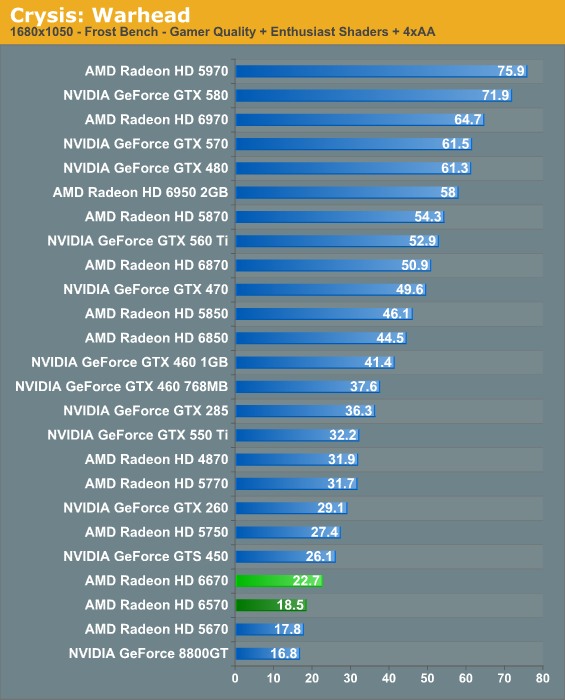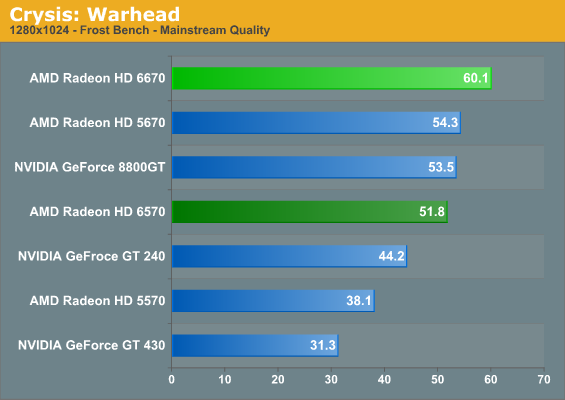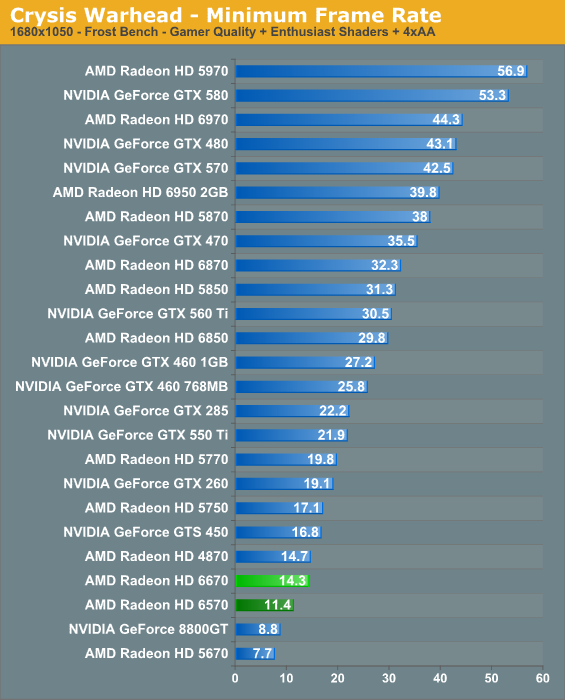AMD’s Radeon HD 6670 & Radeon HD 6570: Two’s Company, Sub-$100’s A Crowd
by Ryan Smith on April 19, 2011 12:01 AM ESTCrysis: Warhead
Kicking things off as always is Crysis: Warhead, still one of the toughest games in our benchmark suite. Even three years since the release of the original Crysis, “but can it run Crysis?” is still an important question, and for three years the answer was “no.” Dual-GPU halo cards can now play it at Enthusiast settings at high resolutions, but for low-end cards even Mainstream/Medium quality is about the best that can be achieved.


It takes a 5770 to crack 30fps in Crysis at 1680x1050, so the fact that the 6670 is only a bit over 20fps isn’t a big surprise. As far as performance at 1680 is concerned Crysis is a good summary of what we’ll see: too slow for 1680, and well behind the next tier of cards represented by the GTS 450 and the Radeon HD 5770/5750. However the 6670 does have a notable advantage here: with 1GB of VRAM it handles 1680 much better than the 512MB 5670, even if it’s ultimately too slow to be playable at these specific settings.
So for the kind of high settings we like to test at, it’s 1280 that’s going to be playable on the 6670, 6570, and similar cards. Once we drop down to 1280 and Mainstream quality the 6670 can crack 60fps, and with a bit of fiddling it should be possible to increase the quality of a setting or two without significantly impacting performance. Overall the 6670 has a 10% lead over the 5670 it replaces, which is a reasonable outcome for a game that’s largely (but not completely) shader-bound.
As for the 6570, it’s well-entrenched near the top of the pack. At 95% of the performance of the 5670 it does quite well, and the next-fastest modern card is the GT 240 which is quite some distance off. Against the 5570 it has a 35% lead, thanks largely to the use of GDDR5 instead of DDR3.
We have also thrown in the 8800GT into our 1280 results, just to offer a different look at performance relative to NVIDIA’s retired champion. It’s a good reference point for where we’re at now, versus what a $300 card did 3 years ago; and once we get to power/temperature/noise testing how better process technology and smaller GPUs have improved those metrics.


Looking at the minimum framerates, the relative ranking of our cards remains unchanged. The 6670 cements its lead over the 5670 here at 1680 thanks to its 1GB of VRAM, while at 1280 the gap narrows significantly to 5%. Meanwhile the 6570 loses ground on the 5670, with the 5670 taking a 10% lead.










53 Comments
View All Comments
codedivine - Tuesday, April 19, 2011 - link
Just a clarification:. I guess these don't support fp64?Ryan Smith - Tuesday, April 19, 2011 - link
Correct. AMD only supports FP64 on the 5800, 5900, and 6900 series.haplo602 - Tuesday, April 19, 2011 - link
6800 do not ?Ryan Smith - Tuesday, April 19, 2011 - link
Also correct. The 6800 series (Barts) does not support FP64; AMD opted not to include it to save on die space.haplo602 - Tuesday, April 19, 2011 - link
awww so my choices got reduced to the 5850 :-(Taft12 - Tuesday, April 19, 2011 - link
At $150, 5850 is the obvious choice anyway (today - 6570/6670 launch day)http://www.newegg.com/Product/Product.aspx?Item=N8...
Macabre215 - Tuesday, April 19, 2011 - link
Eh. If this is your price point you might as well go with a 5670.Taft12 - Tuesday, April 19, 2011 - link
Not if you want the 6xxx-series features.OzzieGT - Saturday, April 23, 2011 - link
Why? 5670 costs only $5 less on newegg right now and it uses more power. I would rather pay the extra $5 for the newest generation card if it offers the same performance.dagamer34 - Tuesday, April 19, 2011 - link
Don't these cards do AMD 3D? That's the only reason for someone to upgrade a previous HTPC card to something with a Turks GPU.